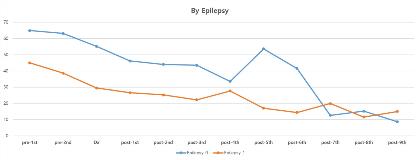Characteristics of the Epilepsies in Pediatric Patients With Nonspecific Mitochondrial Diseases
Abstract number :
1.387
Submission category :
11. Behavior/Neuropsychology/Language / 11B. Pediatrics
Year :
2018
Submission ID :
505960
Source :
www.aesnet.org
Presentation date :
12/1/2018 6:00:00 PM
Published date :
Nov 5, 2018, 18:00 PM
Authors :
Soyong Eom, Yonsei University College of Medicine and Young-Mock Lee, Gangnam Severance Hospital, Yonsei University College of Medicine
Rationale: Epilepsy may be the presenting feature of mitochondrial diseases (MDs) but is often part a multisystem clinical presentation. Mitochondrial epilepsy may be very difficult to manage, and is often a poor prognostic feature. Recent papers indicate that mitochondrial dysfunction can cause a higher proportion of uncategorized nonspecific encephalopathy as well as named disorders. This study aimed to evaluate the characteristics of the epilepsies in pediatric patients with nonspecific MDs. Methods: Of 189 pediatric patients with nonspecific MDs (85 males, 45%), 146 (77%) of the patients have been diagnosed with epilepsy. Disease-related clinical variables of 146 pediatric nonspecific MD patients with epilepsy (63 males, 43%) were reviewed from hospital records and the results of developmental evaluations. Clinical data including seizure semiology, treatment response, neuroimaging findings, and electroencephalography (EEG) were analyzed. Results: The age at onset of symptoms was 1.3±1.7 years (0–9.1 years) and the nature of the initial symptoms varied, with developmental delay (54 patients, 37%) and seizures (83 patients, 57%) being the most frequent. subsequently all subjects experienced seizures. Seizure semiology and EEG abnormalities showed no syndrome-specific findings. Focal seizures were seen in 52 (35.6%), and generalized seizures were seen in 32 (21.9%). All patients were treated with antiepileptic drugs.The time from the first clinical presentation until the confirmative diagnosis of MD was 2.9±2.8 years (0.03–16.9 years), regardless of the initial symptoms. In terms of severity of the clinical manifestations, all patients had involvement of the central nervous system, 44% of patients had elevated serum lactic acid level, followed by 55 of 64 (86%) had mildly elevated levels, and 9 of 64 (14%) moderately and severely elevated levels of serum lactic acid. MRI studies of 66% patients (95 of 146) were abnormal and showed a variety of findings including atrophy or abnormal signals in different areas of the brain. Biochemical evaluation of the MRC enzymatic function in the muscle tissue revealed deficiency of the MRC complexes I and IV in 129 patients (88%) and five patients (3%), respectively. According to muscle biopsy, abnormal mitochondrial morphology was noted under the electron microscope with pleoconia, megaconia, and a combination of these found in 21(14%), 41(28%), and 33(23%), respectively.Long-term follow-up over the course of 7.7 years showed declining trends over all studied periods. In patients diagnosed via syndromic diagnosis of nonspecific MDs, significant differences were shown in patients with epilepsy and in those without epilepsy in Development quotient (DQ). Conclusions: Seizures occur frequently in mitochondrial disease. In terms of epilepsy, the patients who have diagnosed with epilepsy in pediatric patients with MDs showed significantly delayed development compared to those without epilepsy. Epilepsy is a poor prognostic sign in mitochondrial disease, and there is a need for a comprehensive intervention by interdisciplinary approach. Funding: This research was supported by a grant of the Korea Health Technology R&D Project through the Korea Health Industry Development Institute (KHIDI), funded by the Ministry of Health & Welfare, Republic of Korea (grant number:HI18C1166).
